Thomas Michalak, an artist who also works with photography, met Lips at an exhibition in Berlin in 1987. During the last two years of Lips’ life, the friendship intensified. Michalak helped with the organization of exhibitions and began to go through the artwork. He wrote the following text shortly after Lips’ death for “Magnus” magazine.
Thomas Michalak
Roger Lips 1952 - 1994
It was almost eight years ago that I became acquainted with the Cologne photographer Roger Lips during his “Positive-Negative” exhibition in the Berlin café “Anderes Ufer” (Another Shore). The walls of the café looked like a mosaic, papered over with two postcards from the artist – one with a red and one with a green head. A year later I could present a more extensive exhibition of his works at the “Fotogalierie im Wedding” (Photo Gallery in Wedding/Berlin), which I managed together with the photographers Ingo Taubhorn, Thomas Rohloff and Werner Land. From then on a slowly growing friendship bound me to this quiet, sensitive – and then again sometimes impulsive and uncompromising – person called Roger Lips.
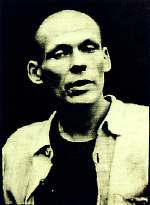 |
Roger Lips did this self-portrait in 1993 from a photo by Thomas Michalak. | |
Although Roger Lips’ work was accessible to the public in the ’80s through many exhibitions (and some of his work is also represented in significant collections), his name and his work is well-known to only a few outside the Cologne area. This is certainly one reason for me to offer this contribution – not as a tribute, but rather once more to present the basis of Roger Lips’ art through some of his more important works.
Roger Lips was trained and educated at the Folkswangschule (Folkswang School) in Essen as a designer. He came to photography via graphics and termed his work for a while “Photo-Graphics” – he looked for new forms in the connection between the two mediums. In the mid-80s – when he did his main work – the theoretical battle over photography as an art form was in full swing. Today, when it is almost taken for granted that artists in the fine arts employ photography and work by contemporary photographers has become “suitable” for the art market, it is hard to imagine that Lips’ work aroused irritated astonishment – on the part of the traditional illustrative photography as well as in the accustomed areas of the fine arts.
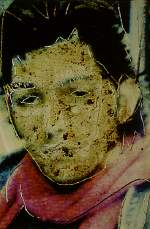 |
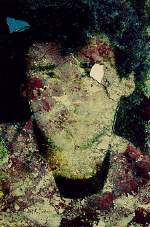 |
|
|
Two
from the series on heads (1986)
|
||
An important group of work from the middle of the ’80s that is exhibited again and again are the “heads” (Lips earlier termed them “portraits”). The starting point is often anonymous pictures taken of young men. Robbed of their personalities by extreme enlargements, chemical and mechanical re-working of the slide, multiple re-copying and also copying one on top of another in layers, these pictures become a kind of icon. Broken and destroyed icons to be sure: erotic, laden with the artist’s projections as well as the viewer’s, they are still not really accessible. Through the destructive, de-constructing signatory approach of the artist, they let a strong tension between affection, longing, rage and destruction be felt.
Around the same time several individual pictures of men’s groups were done. Also robbed of their documentative substance via the above-mentioned techniques, they seem to connect themselves with the fantasies of the viewer and assert a manly-masculine ritualism which precedes and surpasses the rituals of the homosexual subculture.
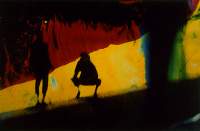 |
Lips called pictures like this one “Scenes” or “Sceneries.” |
Here more deeply rooted forms seem to be dealt with, which – as a careful conjecture – seemed to be more interesting, more powerful, more worthwhile. They were at least queried as a possible counterpart to the interaction of the homosexual subculture.
Again and again Roger Lips grappled with the problem of his HIV-infection (which he found out about quite early on). Under the working title “Positive-Negative,” a series of pictures came about in which – reflecting the meaning of the words – a color slide was enlarged together with a black-and-white negative. Differing from the works up to that point, the protagonists were here no longer photographed from a distance, but rather sections of the pictures are staged with acquaintances and friends in joint sessions. The content too reflects the increased closeness to the subject. Elements of dance-like and theatrical self-production: We experience devotion, security and protection. Their climax is found in a sandwich – that is, in the laying of different slides one on top of another – and double exposure in a large panel painting done as a triptych, whose middle section reminds one of representations of the Crucifixion.
| The side panels were done in 1986, the middle section was added in 1990. |  |
 |
 |
The abstract techniques lose meaning for Roger Lips in the ’90s. He turns to the portrait, photographs the closeness and erotic which can arise between two people who love each other. Dance becomes an important theme as the direct physical expression of how one feels. And once again he grappled with the subject of AIDS and the laws of the homosexual subculture, which he finds to be unloving and mechanical. In an impressive triptych he contrasts a multitude of porno “blow jobs” with the warm-toned pictures of two forearms and hands that are opened towards one another for giving as well as receiving.
 |
 |
|
|
conserver sex links = oben sowie als auch unten = conserver sex rechts (Artificial “canned” sex (left); above as well as below: artificial “canned” sex (right)), 1992 |
||
The ambivalence, the questioning of possibilities in the earlier works has yielded to a clear moral standpoint in the works of this group.
Roger Lips’ last project, finished a few months before his death, impresses me very much because at the end of his life his work turns back to the childhood. In theses last black-and-white works Roger Lips returns also to the old re-working techniques. One sees 20 faces of the baby boy Noah. The eye sockets remain black. Strangely empty, they remind one of death’s-heads. In everyone one of these slightly out of focus pictures, whose brown-tone reminds one of one’s own childhood pictures, the endangerment and seeming arbitrariness of living human development can be felt. Here is the moment where the child seems to carry all the possibilities within himself, his social and individual formation in which roots have already begun for all the later fortune and misfortune.
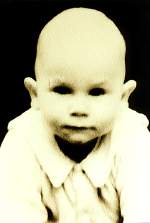 |
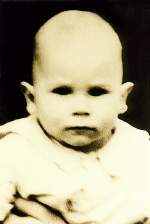 |
|
|
Two
from the series of 20 pictures from Lips’ last work in 1994.
|
||
Roger Lips died on December 27, 1994 as a result of AIDS.
Thomas Michalak, Cologne, 1995